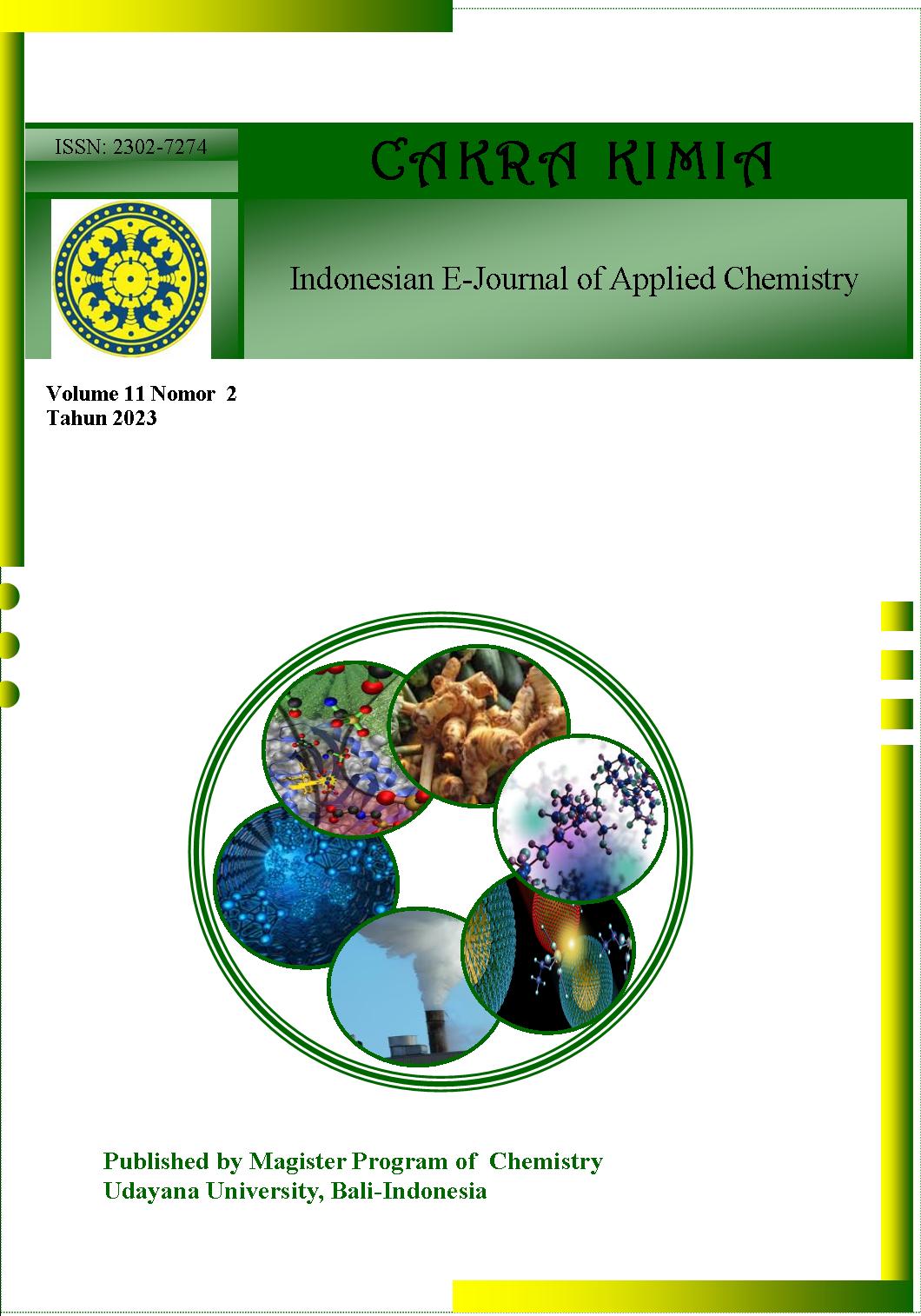PENGOLAHAN LIMBAH LAUNDRY DENGAN METODE FENTON
Abstract
ABSTRAK : Saat ini penggunaan detergen semakin meningkat seiring dengan pertumbuhan jumlah penduduk setiap tahunnya, serta berkembang pesatnya usaha rumah tangga, termasuk jasa laundry. Deterjen adalah bahan kimia yang mengandung surfaktan, digunakan sebagai bahan pembersih rumah tangga, industri, dll. Air limbah laundry mengandung fosfat, amonia, nitrogen dan Total Suspended Solid (TSS), Turbidity dan kebutuhan Biological Oxygen Demand (BOD). dan kebutuhan Chemical Oxygen Demand (COD) dengan konsentrasi yang tinggi. Tujuan pengolahan limbah adalah untuk menghilangkan kontaminan dari limbah, baik industri maupun domestik. Metode Fenton merupakan salah satu kebaharuan teknologi Advance Oxidation Process (AOPs), dimana pada reaksi fenton akan terbentuk gugus radikal hidroksil yang dapat mendegradasi polutan organik dan anorganik yang terkandung dalam limbah cair. Hasil penelitian pengolahan limbah cair laundry dengan metode Fenton pada perbandingan rasio H2O2/COD memberikan efisiensi penyisihan COD tertinggi terjadi pada rasio 10:1 (g/g) dengan presentase penyisihan sebesar 78%, sedangkan untuk perbandingan rasio H2O2/Fe2+ memberikan efisiensi penyisihan COD tertinggi terjadi pada rasio 5:1 (g/g) dengan presentase penyisihan sebesar 84%. Menurut hasil pengolahan limbah cair laundry dengan metode fenton yang telah dilakukan, bahwa efektivitas reaksi pada fenton dipengaruhi oleh perbandingan rasio H2O2/COD dan perbandingan rasio H2O2/Fe2+
ABSTRACT : Currently, the usage of detergent has grown over time due to the increasing in people population and the quick expansion of businesses in residential areas, one of which is the laundry service industry. Detergent is a cleaning product with surfactants that is used in industrial, domestic, and other washing applications. High quantities of phosphate, ammonia, nitrogen, and Total Suspended Solid (TSS), as well as turbidity, Biological Oxygen Demand (BOD), and chemical oxygen demand (COD) are found in the waste water produced by laundry activities. The Fenton technique is one of the advancements of the Advance Oxidation Process (AOPs) technology. In the Fenton method, hydroxyl radical groups are created by a reaction between hydrogen peroxide (H2O2) and ferrous ion Fe2+ that can oxidize both organic and inorganic molecules in wastewater. According to study on laundry wastewater treatment using the Fenton technique, the highest COD removal efficiency was found at a ratio of 10:1 (g/g), with a removal percentage of 78% while the COD removal efficiency was found for the comparison of the H2O2/Fe2+ ratio. the greatest occurred at a 5:1 (g/g) ratio with an 84% elimination rate. In conclusion, the H2O2/COD ratio and the H2O2/Fe2+ ratio have an impact on how well the reaction on the Fenton works according to the results of the Fenton method used to treat the laundry wastewater.
Downloads
References
[2] Collvignarelli M. C., Pedrazzani R., Sorlini R., Abba A., Bertanza G. H2O2 Based Oxidation Processes For The Treatment Of Real High Strength Aqueous Wastes. Sustainability Switzerland, 9(2), 1-14. 2017
[3] Cortez S., Teixeira P., Oliveira R., Mota M. Evaluation Of Fenton And Ozone-Based Advanced Oxidation Processes As Mature Landfill Leachate Pre-Treatments. Journal Of Environmental Management 92, 149-755. 2011.
[4] Deng Y., Zhao R. Advanced Oxidation Processes (AOPs) in Wastewater Treatment. Curr Polution Rep 1:167-176. 2015.
[5] Fauzi A. R., Agung T. R. Kombinasi Fenton Dan Fotokatalis Sebagai Alternatif Pengolahan Limbah Batik. Jurnal Envirotek 10 (1). 2018.
[6] Hakim L. Pengolahan Limbah Laundry Dengan Menggunakan Tanaman Kenaf (Hibiscus Cannabinus L.). Institut Teknologi Sepuluh November. Surabaya. 2016.
[7] Hu C., Huang D., Zeng G., Cheng M., Gong X., Wang R., Xue W., Hu Z., Liu Y. The Combination Of Fenton Process And Phanerochaete Chrysosporium For The Removal Of Bisphenol A In River Sediments: Mechanism Related To Extracellular Enzyme, Organic Acid And Iron. Chemical Engineering Journal 338, 432-439. 2018.
[8] Kang S. F., Liao C. H., Chen M. C. Pre-Oxidation And Coagulation Of Textile Wastewater By Fenton Process. Chemosphere 46 923-928. 2002.
[9] Lesa W. S., Ali M., Rosariawari F. Proses Foto Fenton Dalam Reaktor Resirkulasi Untuk Menyisihkan Beban Pencemar Pada Lindi. Jukung Jurnal Teknik Lingkungan, 6 (1): 54-65, 2020.
[10] Li X., Chen S., Angelidaki I., Zhang Y. Bio-Electro-Fenton Processes For Wastewater Treatment: Advances And Propects. Chemical Engineering Journal. 2018.
[11] Panizza M., Cerisola G. Electro-Fenton Degradation Of Synthetic Dyes. Water Research 43, 339-344. 2009.
[12] Putri F. A., Sarto., Yuliansyah A. T. Pengaruh Variaasi Rasio H2O2/COD Dan Tegangan Terhadap Penurunan COD Air Limbah Rumah Sakit Dengan Metode Elektro – Fenton. Jurnal Chemurgy, 04 ( 02). 2019.
[13] Setiawan O., Sarto., Cahyono R. B. Pengaruh pH Dan Rasio COD/H2O2 Terhadap Penurunan COD Pada Limbah Cair Rumah Sakit Melalui Metode Fenton. Universitas Gajah Mada Yogyakarta. 2020.
[14] Tamas I. N. Proses Fenton Pada Pengolahan Lindi TPA Ngipik Gresik. Institut Teknologi Sepuluh November Surabaya. 2017.
[15] Wang Q., Tian S., Ning P. Ferrocene-Catalyzed Heterogeneous Fenton -Like Degradation Of Methylee Blue: Influence Of Initial Solution pH. Ind. Eng. Chem. Res., 53, 15, 6334-6340. 2014.
[16] Wardiyati S., Dewi S.H., Fisli A. Dekolorisasi Limbah Industri Batik Menggunakan Proses Fenton Dan Foto Fenton. PTBIN BATAN Serpong. 2012.



 Petunjuk Penulisan
Petunjuk Penulisan
